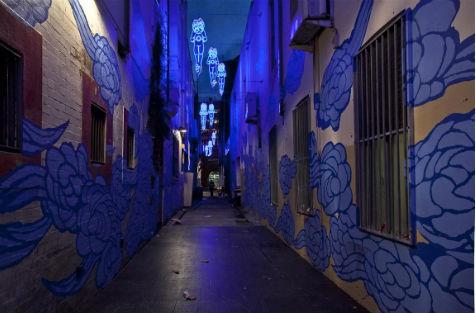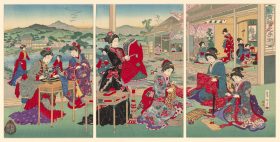The City of Sydney is embarking on a search for new public artworks, offering great opportunities for artists with new ideas.
The City of Sydney, City Art program has invited artists to submit expressions of interest for the commission of public artwork in three Sydney areas.
The City is seeking artists for the ‘spine’ of George Street, in the hustle and bustle of the city centre. Another is for the east-west connecting streets that cross George Street and travel in east-west directions across the CBD. A final call out is for artworks to integrate public art in the Drying Green, a park within the Green Square urban development site.
When an artist considers putting in an expression of interest, what is actually possible?
Creating art for the public realm is a delicate task. Cities are complex, moving beasts filled with shifting perspectives and living histories. An area can change around the clock, experiencing times of frantic commerce in one hour and total abandonment in the next.
For an artwork to exist successfully within the public realm it must take all this and more into consideration, while at the same time resonating with themes relevant to the city.
The City Art City Centre Public Art Plan, written by City Centre Curatorial Advisor Barbara Flynn, in collaboration with City Design, outlines a host of artistic approaches towards public artwork that can be considered when devising a vision.
An artist might choose to make a landmark work of public art that is prominent and imposing. Then again, they may choose to create multiple and connected micro-works, adding a more subtle texture to the public space, and an element of discovery.
They could explore the more functional idea of incorporating sculptural art with seating, or even play equipment. Alternatively, the work could direct the viewer towards a particular sight, such as an historical building or a scenic view, or incorporate vegetation in its design.
Position must also be considered. Art could be placed up high above the urban sprawl, as art gateways or towers. It could be spread over ground level as a unique paving treatment. It could even fill void areas, such as the narrow strips between buildings, essentially creating extra space.
While all these options are highlighted in the City Centre Public Art Plan as possibilities for George Street and the east-west connecting streets, Flynn is quick to point out that the plan is intended as a guide, and any examples it discusses are indicative of types of art being created in cities across the globe.
‘We hope artists will come up with new ideas that are even better than the indicative examples and approaches cited in the City Centre Public Art Plan,’ said Flynn.
One thing City Art would like, however, is a balance of permanent and temporary artworks in line with modern curatorial trends.
The inclusion of temporary work is a way of allowing younger artists a chance to work in the public sphere. According to Flynn, ‘Urban projects are complex, and experience is helpful. Temporary works of art provide a way for a young artist to accrue experience and learn how to make a work in the public realm.’
The chance for experimentation is definitely richer within this context. ‘It’s a testing ground,’ said Flynn, ‘and if an artist were to do something that doesn’t quite succeed or that is controversial, it’s temporary — less confronting.’
An interesting option within a temporary approach is the idea of performance works. Flynn said, ‘We feel that could be a very exciting program to run, especially during the construction phase as a way of making the city more enjoyable during that time.’
There is also the notion of creating partnerships with specialists and private enterprises. ‘Given the scale of George Street and the east-west connecting streets, and the complexity of the challenge, artists who can demonstrate the capacity to work on a complex infrastructure project will have the greatest chance of being successful … Artists are invited to apply individually or to form teams comprising others with expertise, for example, in architecture, landscape architecture, and/or urban design,’ said Flynn.
As the artwork is to be exhibited in public there are certain fundamentals that shouldn’t be ignored.
‘It’s the public realm so safety’s important,’ said Flynn. ‘Also something like durability … by which I mean robust in material — don’t forget, these will be works of art located the out of doors — as well as content or message, providing one that will be relevant to people over time.’
These are just some of the things Jason Wing had to consider when he devised his 2011 City of Sydney, City Art public art commission, In between two worlds, which was a mix of wall murals and suspended sculptures repeated through Kimber Lane, Chinatown and illuminated with LED lighting.
Before he negotiated the finer details of a public commission his first step was to understand the space.
‘First of all I like to just be absorbed in the space and understand how it functions, how people interact and how it can be improved. Then I break down the specific requirements of the brief and add my thumbprint,’ said Wing.
Aesthetics, safety, and local and international significance were built on this informed spatial understanding and a meaningful work was produced.
Creating a piece of public art is no small feat. The approaches are diverse and the challenge to achieve unity and thematic relevancy requires much creativity and consideration. It is, however, a unique chance to connect with a diverse audience and, for the right artist, an exciting chance to shape a city.
According to City of Sydney’s Design Director Bridget Smyth, ‘These are unique opportunities for artists to be part of the transformation of our city and to refocus on the quality of life for the people who live within it.’
For more information read the Green Square Public Art Strategy, the City Centre Public Art Plan, or visit the City Art site.
(Pictured: ‘In between two worlds’ by Jason Wing (2011))





